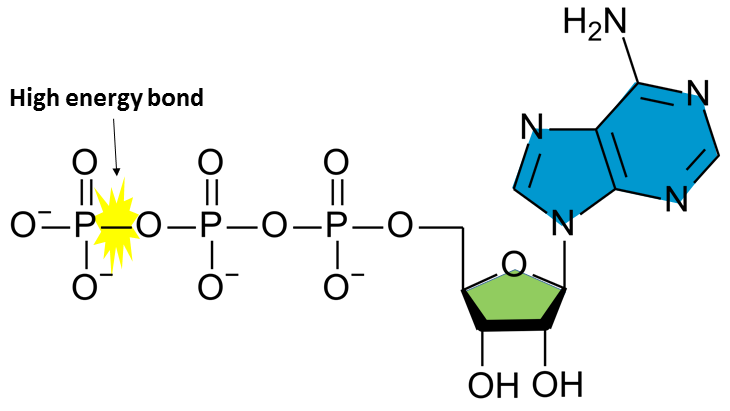
Which bond of ATP is considered high energy?
Answer
490.5k+ views
Hint: The energy currency of the cell is ATP, or adenosine triphosphate. Phosphate groups, adenine, and the sugar ribose make up this chemical molecule. These molecules supply energy to the body's many metabolic operations. As a result, it is known as the "Energy Currency of the Cell”. These organic compounds work by absorbing chemical energy from digested food molecules and then releasing it for various cellular operations. Adenosine triphosphate (ATP) is necessary for a number of biological activities, including molecule transport across cell membranes.
Complete answer:
Adenosine triphosphate is a nucleotide made up mostly of the adenosine molecule and three phosphate groups. These three phosphate groups are connected by two phosphoanhydride bonds, which are high-energy bonds. It has a high energy content and is soluble in water, owing to the existence of two phosphoanhydride bonds connecting the three phosphate groups.
The three phosphate groups are linked in a chain to the pentose sugar's fifth carbon. The phosphoryl groups are referred to as alpha, beta, and gamma phosphates, commencing with the group nearest to the ribose sugar. These phosphates play a crucial part in ATP's action.
The three phosphate groups in this ATP molecule are known as high energy bonds because when they are broken, they release a large amount of energy. This molecule supplies energy for a variety of biological activities, without which life would be unable to exist. Various enzymes and structural proteins utilise it in biosynthetic activities, cell divisions, and other cellular activities. During cellular respiration, a digested simple molecule of food is used to create this "energy currency of the cell."

Additional information:
ATP is required for a variety of cellular processes, including the transfer of molecules across cell membranes. Other roles of ATP include providing energy for muscular contraction, blood circulation, locomotion, and other body motions. Aside from energy production, ATP plays an important function in the cell's survival by generating the thousands of different macromolecules it needs. The ATP molecule can also be utilised to control chemical reactions and deliver signals.
Note:
Adenosine triphosphate is the chemical formula for ATP. The sugar ribose, adenine, and phosphate groups make up this chemical molecule or complex. These are the energy-carrying molecules that can be found in all of the body's cells. They play an important function in capturing chemical energy from digested food and distributing it to all cells for cellular processes. These ATP molecules give energy to cells for a variety of biological operations, and are hence referred to as the cell's energy currency.
Complete answer:
Adenosine triphosphate is a nucleotide made up mostly of the adenosine molecule and three phosphate groups. These three phosphate groups are connected by two phosphoanhydride bonds, which are high-energy bonds. It has a high energy content and is soluble in water, owing to the existence of two phosphoanhydride bonds connecting the three phosphate groups.
The three phosphate groups are linked in a chain to the pentose sugar's fifth carbon. The phosphoryl groups are referred to as alpha, beta, and gamma phosphates, commencing with the group nearest to the ribose sugar. These phosphates play a crucial part in ATP's action.
The three phosphate groups in this ATP molecule are known as high energy bonds because when they are broken, they release a large amount of energy. This molecule supplies energy for a variety of biological activities, without which life would be unable to exist. Various enzymes and structural proteins utilise it in biosynthetic activities, cell divisions, and other cellular activities. During cellular respiration, a digested simple molecule of food is used to create this "energy currency of the cell."

Additional information:
ATP is required for a variety of cellular processes, including the transfer of molecules across cell membranes. Other roles of ATP include providing energy for muscular contraction, blood circulation, locomotion, and other body motions. Aside from energy production, ATP plays an important function in the cell's survival by generating the thousands of different macromolecules it needs. The ATP molecule can also be utilised to control chemical reactions and deliver signals.
Note:
Adenosine triphosphate is the chemical formula for ATP. The sugar ribose, adenine, and phosphate groups make up this chemical molecule or complex. These are the energy-carrying molecules that can be found in all of the body's cells. They play an important function in capturing chemical energy from digested food and distributing it to all cells for cellular processes. These ATP molecules give energy to cells for a variety of biological operations, and are hence referred to as the cell's energy currency.
Recently Updated Pages
Master Class 12 Business Studies: Engaging Questions & Answers for Success

Master Class 12 Economics: Engaging Questions & Answers for Success

Master Class 12 English: Engaging Questions & Answers for Success

Master Class 12 Maths: Engaging Questions & Answers for Success

Master Class 12 Social Science: Engaging Questions & Answers for Success

Master Class 12 Chemistry: Engaging Questions & Answers for Success

Trending doubts
What are the major means of transport Explain each class 12 social science CBSE

Which are the Top 10 Largest Countries of the World?

Draw a labelled sketch of the human eye class 12 physics CBSE

How much time does it take to bleed after eating p class 12 biology CBSE

Explain sex determination in humans with line diag class 12 biology CBSE

Differentiate between homogeneous and heterogeneous class 12 chemistry CBSE




